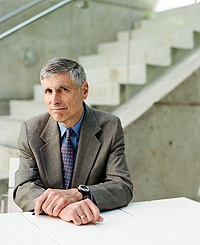SUMMER 2009 CONTENTS
Home
In the crosshairs
Basic science under the microscope
Harkin’s hope
Re-creating America as a wellness society
Anatomy of an experiment
Chasing down the cell’s gatekeepers
The Catalysts
How the farm became a giant force in biology
Crossovers
Learning to speak “doctor”
The science pages
Scientists built the web. Do they love web 2.0?
Opening doors
Finding funding for graduate students in basic science


Leslie Williamson

In this issue of Stanford Medicine, we celebrate basic science.
Stanford medical faculty and students have a record of tremendous basic science achievement — a record that to a great extent defines the medical school and grants it distinction. The pursuit of basic research is one of Stanford’s core values, and for good reason: The successes of basic research have built clinical medicine as we know it today.
That said, “basic” research has sometimes been valued over work that is applied, or “clinical,” as if it required a greater degree of intellectual rigor. Of course there is no question that insights in genetics and molecular biology, for example, have opened avenues for healing and preventing disease, ranging from personalized cancer treatments to prenatal genetic tests. Clearly, basic and clinical science exist on a continuum — and the individuals who carry out this work ultimately need to be connected to optimize our ability to improve the health of our communities.
Thus, for nearly two decades pressure has been mounting to translate basic science discoveries into more clinical advances. Toward this end, initiatives from the National Institutes of Health, private foundations and individual research institutions, including Stanford, increasingly direct support to more clinically focused work. The result is higher esteem for applied research, while still recognizing the importance of basic science as the foundation for medical progress. The hope is to speed the translation of basic science insights into health-care advances.
So it is fitting that this issue of Stanford Medicine acknowledges our efforts to expand opportunities for basic scientists to explore the world of clinicians and vice versa. Through our Master’s of Science in Medicine Program, students immersed in the world of basic research become more conversant in clinical medicine. And the Advanced Residency Training at Stanford program gives a select few MDs entry into a PhD program to pursue research. These and similar programs are designed to promote discourse and, we hope, fruitful collaborations. They are not meant to subordinate either basic or clinical science but rather to elevate both, and create pathways for interaction.
Biomedical research in the United States is largely supported by grants and contracts from the NIH or foundations like the Howard Hughes Medical Institute. In the four years prior to 2009, the NIH budget’s purchasing power had declined, and the Bush administration and Republican leaders had increasingly expressed an anti-science bias. Although the $10 billion infusion for NIH research that Senators Tom Harkin and Arlen Specter included in President Obama’s economic stimulus package has boosted NIH funding temporarily, a healthy future for scientific research requires continued advocacy. Fortunately, the renewed support for science and technology by the Obama administration gives hope — and the excellence of the basic research community at Stanford offers promise for continued discovery and innovation that will transform the future of science and medicine. This too is worth celebrating.
Sincerely,
Philip A. Pizzo, MD
Dean
Stanford University School of Medicine
Carl and Elizabeth Naumann Professor, Pediatrics, Microbiology and Immunology

